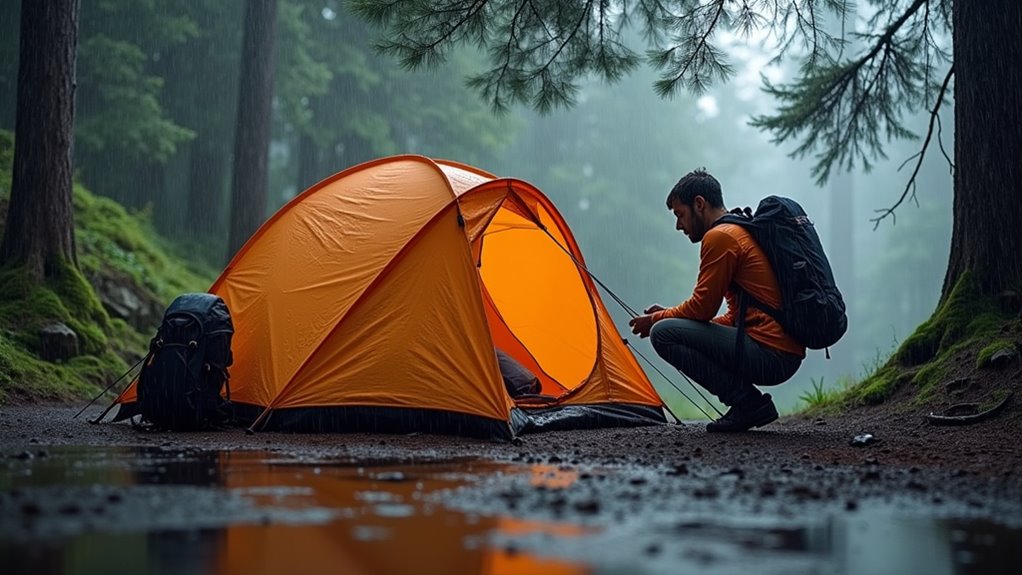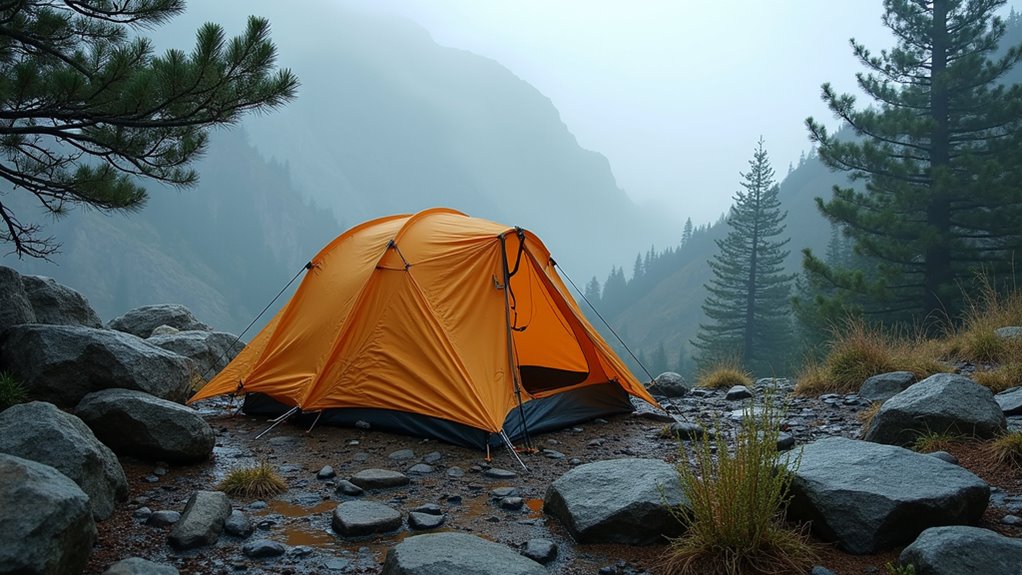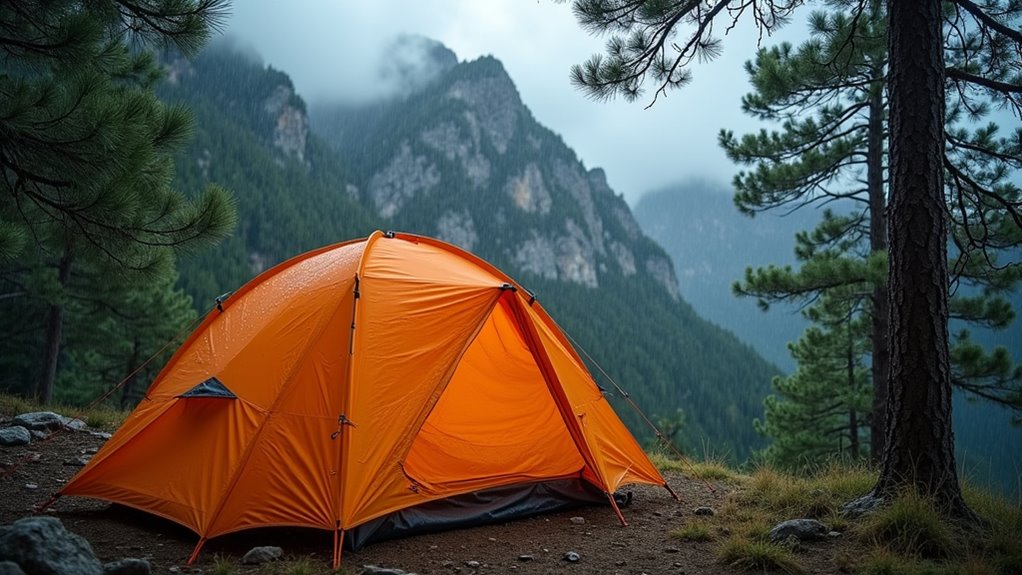Physical Address
304 North Cardinal St.
Dorchester Center, MA 02124
Physical Address
304 North Cardinal St.
Dorchester Center, MA 02124

How to survive dangerous storms and protect yourself when Mother Nature turns your peaceful camping trip into a fight for safety and survival.
Picture yourself huddled in your tent as rain hammers the fabric above and wind threatens to tear out your stakes—you’re facing every camper’s nightmare scenario. Bad weather doesn’t just ruin your outdoor plans; it can quickly turn dangerous if you’re unprepared. Whether you’re dealing with sudden thunderstorms, unexpected temperature drops, or howling winds, knowing how to respond properly can mean the difference between a minor inconvenience and a genuine emergency that cuts your trip short.

Before you pack your tent and hit the trail, you’ll want to become your own meteorologist for a few days. Check multiple weather sources—don’t rely on just one app. The National Weather Service provides detailed forecasts, while local news often includes regional insights that generic apps miss.
Watch for red flags like dropping barometric pressure, sudden temperature swings, or wind pattern changes. These often signal incoming storms hours before they hit. Pay attention to seasonal patterns too—afternoon thunderstorms are common in summer mountains, while spring brings unpredictable fronts.
Study satellite imagery to track storm systems approaching your camping area. Cloud formations tell stories: towering cumulus clouds spell trouble, while thin, wispy cirrus clouds usually mean fair weather’s continuing. This knowledge helps you time your departure perfectly.
Just as you’d research travel insurance options before an international trip, invest time in understanding your camping destination’s weather patterns and potential risks.
While predicting weather helps you prepare, packing the right storm gear can literally save your life when conditions turn dangerous. You’ll need a four-season tent rated for high winds, plus extra stakes and guy lines. Pack a quality rain shell and pants – not just water-resistant, but fully waterproof.
When storms strike, the difference between water-resistant and waterproof gear becomes a matter of survival, not comfort.
Emergency shelter like a bivy sack or tarp provides backup protection if your tent fails.
Don’t forget communication tools: a weather radio, satellite communicator, or emergency beacon for remote areas. Headlamps with extra batteries are essential since storms often bring darkness. Include fire starters that work when wet, emergency food rations, and a first aid kit.
Finally, carry rope or paracord for securing gear and creating windbreaks. Proper layering systems with moisture-wicking base layers and insulating mid-layers help regulate body temperature when wet conditions threaten hypothermia. This gear transforms potential disasters into manageable challenges.

Once you’ve assembled your storm gear, you’ll need to transform your campsite into a fortress that can withstand nature’s assault. Start by anchoring your tent with additional guy-lines and stakes—standard tent stakes won’t cut it in severe weather. Drive them at 45-degree angles for maximum holding power.
Create wind barriers using tarps stretched between trees or your vehicle. Position these barriers upwind from your tent to deflect gusts.
For rain protection, establish proper drainage by digging shallow trenches around your tent’s perimeter, directing water away from your sleeping area.
When temperatures plummet, insulate your tent’s floor with extra tarps or sleeping pads. Keep gear dry by storing everything in waterproof bags inside your tent’s vestibule, not directly on the ground where moisture accumulates.
If you’re making last-minute campsite reservations due to changing weather conditions, consider using credit card reservations which offer better fraud protection and dispute resolution compared to other payment methods.
Even the most fortified campsite won’t keep you comfortable if you’re not prepared to manage your body temperature and moisture levels when the storm arrives. Layer your clothing strategically—start with moisture-wicking base layers, add insulating fleece or down, then finish with waterproof outer shells. Keep spare dry clothes in waterproof bags inside your tent.
Change out of wet clothing immediately, even if it means briefly exposing yourself to cold air. Wet fabric sucks heat from your body twenty-five times faster than dry material.
Pack chemical hand warmers for quick heat boosts, and don’t forget wool socks—they’ll keep your feet warm even when damp.
Stay hydrated and eat high-calorie foods to fuel your internal furnace during temperature drops. When preparing for storms, remember that low impact camping principles still apply—choose gear and strategies that minimize your environmental footprint while keeping you safe.

When thunderstorms threaten your campsite, you’ll need different tactics than what works for steady rain or high winds.
For lightning, immediately seek hard-shell shelter like your car or a permanent building—never huddle under trees. If you’re stuck in a tent, crouch on your sleeping pad with feet together, avoiding tent walls and metal objects.
During high winds, secure your tent with extra guy lines and stakes. Position it behind natural windbreaks like boulders or dense vegetation.
In tornado-prone areas, identify the lowest ground nearby, like ditches or depressions.
For hail, protect yourself inside your vehicle if possible. Your tent won’t provide adequate protection from large hailstones.
Always monitor weather alerts on your phone or weather radio before conditions deteriorate.
Having reliable camping gear that can withstand harsh conditions is essential for weathering storms safely.
While shelter strategies can protect you from many weather hazards, there comes a point where staying put becomes more dangerous than leaving. You’ll need to evaluate conditions objectively, not emotionally.
If you’re facing flash flood warnings, tornado watches, or approaching wildfires, don’t hesitate—pack essentials and head to safer ground immediately.
Weather apps and emergency alerts should guide your decisions, but trust your instincts too. If winds are strong enough to threaten large trees near your campsite, or if water levels are rising rapidly, it’s time to go.
Plan evacuation routes before bad weather hits, and always inform someone about your camping plans. Having the right cold-weather gear packed and ready can make all the difference if you need to evacuate during winter conditions or unexpected temperature drops.
Remember, you can’t control Mother Nature, but you can outsmart her with proper preparation and quick thinking. Don’t let pride cloud your judgment—when conditions turn dangerous, there’s no shame in cutting your trip short. Trust your instincts, stay flexible with your plans, and keep safety as your top priority. The wilderness will always be there for another adventure, but you’ve only got one life. Weather the storm wisely, and you’ll have countless more camping memories ahead.